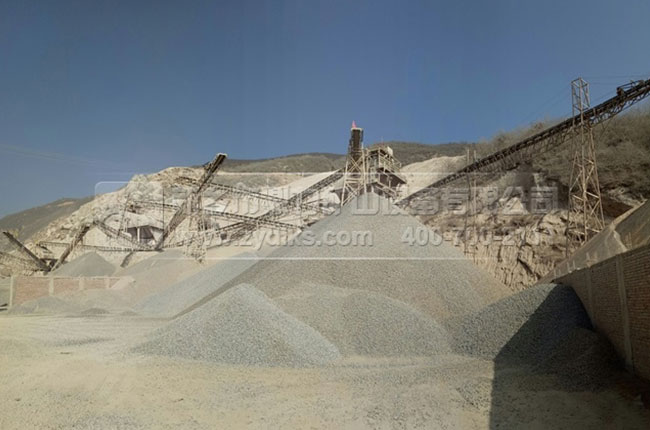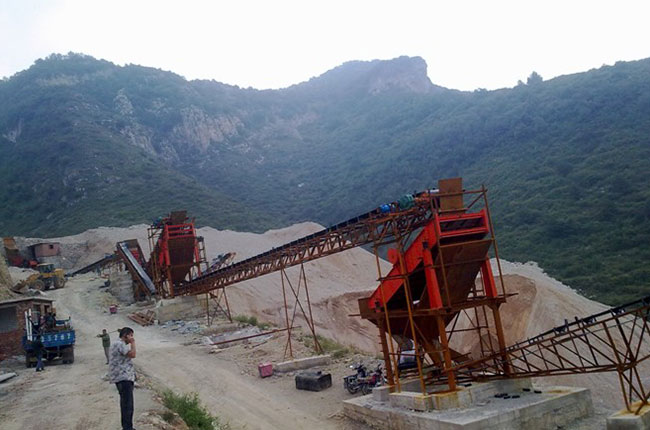 Sand Aggregate IndustryComprehensive Service Provider
Sand Aggregate IndustryComprehensive Service Provider Sand Aggregate IndustryComprehensive Service Provider
Sand Aggregate IndustryComprehensive Service Provider| Model | Eccentricity | Maximum Motor Installation Power (kW) | Throughput under Closed side Discharge Opening (CSS) (t/h) | ||||
| 30mm | 35mm | 40mm | 45mm | 50mm | |||
| GPY400S | 36 | 280 | 400 - 450 | 440 - 490 | 480 - 520 | 500 - 540 | 550 - 600 |
| 42 | 520 - 570 | 550 - 630 | 620 - 670 | 650 - 700 | |||
*Note: The processing capacity of the GPY400S cone crusher may vary with different materials and feeding sizes.

After being conveyed to the heavy hammer crusher by the vibrating feeder the material successively goes through coarse & fine crushing and screening by gradation.

After entering into the market in Gansu province Dingli expanded its business continuously. With improved one-stop service we have won trust from the customers since our after-sale service staffs will visit the production site for solving

This 600t/h production line has the basic configuration of PCZ1615 heavy hammer crusher PC1213 hammer crusher ZG1538 feeder 3YKZ2670 vibrating screen*2 sets 2YKZ2670 vibrating screen*2 sets.
Medium crushing cone crushers play a significant role in the mineral processing and aggregate production sectors. Their proper functioning is essential for efficient and effective crushing operations.
The main parts of a medium crushing cone crusher consist of a frame, a transmission device, a crushing cone (movable cone), a fixed cone, a mantle, a concave, and a lubrication and hydraulic system. The crushing cone is supported by a spherical bearing and is driven by an eccentric shaft sleeve. The rotation of the eccentric shaft sleeve within the crusher frame makes the crushing cone perform a gyratory motion.
When the crusher is in operation, the material to be crushed is fed into the crushing chamber via the feed opening. The crushing chamber is formed by the mantle on the crushing cone and the concave on the fixed cone. As the crushing cone rotates, the distance between the mantle and the concave varies continuously. When the crushing cone approaches the fixed cone, the material is squeezed and crushed between them. This compressive force is strong enough to break hard rocks.
The design of the crushing chamber enables a step-by-step reduction in the material size. The material first enters the upper part of the chamber for an initial crushing stage and then moves downward for further refinement until it reaches the desired size. The crushed material is then discharged from the bottom of the crusher.
The hydraulic system in a medium crushing cone crusher is crucial. It is used to adjust the discharge opening size, which directly determines the final product size. By regulating the hydraulic pressure, operators can precisely set the gap between the mantle and the concave, achieving the desired particle size distribution of the crushed product. Moreover, the hydraulic system provides overload protection. If uncrushable objects enter the crushing chamber, it automatically adjusts to allow the crushing cone to move back, preventing damage to the crusher. Once the object is removed, the crusher can resume normal operation quickly.
The lubrication system is also vital. It ensures that all moving parts, such as the eccentric shaft sleeve, the spherical bearing, and the gears in the transmission device, are well lubricated. Adequate lubrication reduces friction and wear, extends the service life of the equipment, and guarantees its stable and reliable operation.
In conclusion, medium crushing cone crushers operate based on the principle of the gyratory motion of the crushing cone and the interaction between the mantle and the concave. The combination of the hydraulic and lubrication systems enhances their functionality and reliability, making them highly efficient and widely used in various industries. Understanding their working principle is the key to optimizing their performance and achieving better crushing results.
We are present worldwide and always here to help.
Get in touch today!